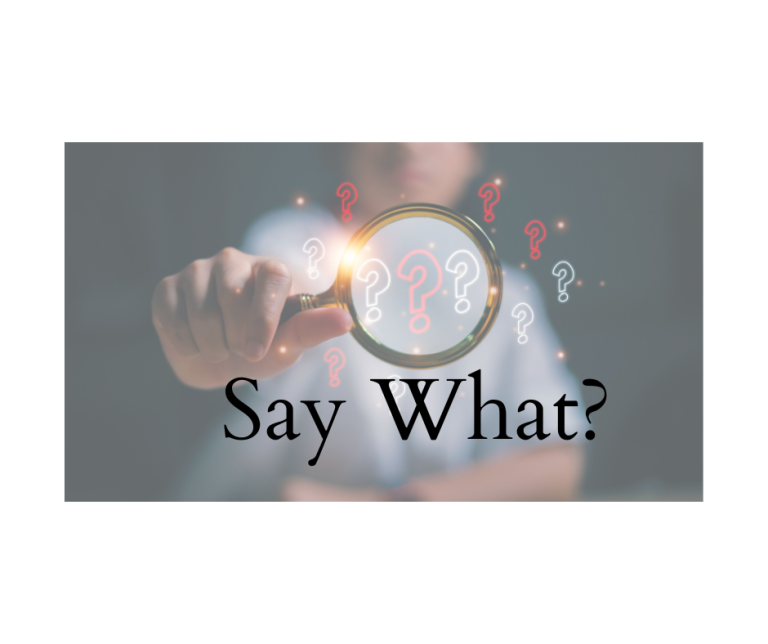Writers, Wipe That Smile off Your Page
This week editor Robin Patchen wraps up our look at Fatal Flaw #11 – Pesky Adverbs and Weasel Words. If you’ve missed the other posts, start with this one here.
It’s been said (by someone) that 93% of communication is nonverbal, and of that, 55% is pure body language, including facial expressions, hand gestures, and postures.
For instance, take the word sure. If it’s delivered with a big smile, it means something very different than when it’s delivered with a glare. One is agreement, the other sarcasm or distrust.
We authors know this—we’re students of human interaction, after all. So it makes sense that we so often include facial expressions and body language in our stories.
But these nonverbal descriptions can quickly become weasel words and bulky phrases, shoved into our paragraphs to convey quickly—and perhaps lazily—our characters’ feelings and reactions.
Let’s jump right into an example.
Before:
“So.” Brady leveled a glare at her. “Are you going to tell me about him?”
Rae’s heartbeat kicked into high gear as she imagined her son upstairs. “Him who?”
He frowned. “The man who put that ring on your finger.”
She sighed in relief and tried to smile. “What do you want to know?”
“Where is he?” Brady’s face took on a quizzical look.
“Paris.”
Brady’s eyebrows lifted. “Why isn’t he with you?”
She made her face impassive. “Work.”
Brady closed his lips in a tight line.
“What?” she asked.
He took a deep breath and blew it out. “You don’t offer much, huh?”
She shrugged, and he continued. “So—Paris. Is that where you’ve been living?” He ran a hand through his hair. “Dorothy told me you were in Africa somewhere.”
“He has an apartment in Paris.” She wrung her hands beneath the table. “He’s there now.”
Brady’s eyebrows lifted again, then fell, and he nodded. “When are you going back?”
“Soon as I can.” She blinked a few times. “You want something else?”
He nodded to the bag. “You pick first.”
She chose the blueberry scone. “That okay?”
He chuckled. “I knew you’d pick that one. You always were a sucker for blueberries.”
She giggled, remembering the time they’d picked enough blueberries from the bushes out back for a couple of pies, then eaten so many Gram had scolded them. By the look on Brady’s face, he remembered it too.
She shrugged. “Not a lot of blueberries in Tunis.”
Emotional Placeholders
A moment of transparency here. The above segment?—that’s often what my first drafts look like. When I’m getting the plot on the page, focusing on building deep, multifaceted characters, I dump lots of that stuff into my prose. They’re sort of like emotional placeholders.
But I try not to keep them, because as you saw in that last segment, they can get overused very quickly. Yes, people smile and shrug and nod. And in real life, we do all those things all the time. But real life is boring. Don’t believe me? Turn on C-Span.
Figure out what your weasel words and bulky phrases are with regard to facial expressions and bodily motions. For some reason, my characters are often shown breathing—she sighs, he heaves a breath, she takes a deep breath, he blows out a breath. It’s as though if I don’t write that they breathe, they might just suffocate on the page.
Figure out what yours are and delete them— or replace them with something better.
After:
“So.” Brady finished his sandwich and wiped his fingers on a napkin. “Are you going to tell me about him?”
Rae pictured Johnny sleeping soundly upstairs. How did Brady know? “Him who?”
“The man who put that ring on your finger.”
Right. Him. “What about him?”
“Where is he?”
“Paris.”
“Why isn’t he with you?”
“Work.”
Brady closed his lips in a tight line, and she recognized the look of frustration. “What?”
He took a deep breath and blew it out. “You don’t offer much, huh?”
She took another bite of her sandwich but barely tasted it.
“So, Paris,” he said. “Is that where you’ve been living? Dorothy told me you were in Africa somewhere.”
She set the sandwich down. “He has an apartment in Paris.”
Brady seemed to be waiting for her to say something, but she’d probably already said too much. After a moment, he continued. “When are you going back?”
“Soon as I can.” She grabbed the basket of scones off the counter. No reason to panic. All she had to do was convince Brady that all was well with her and Julien.
Rae’d perfected the art of lying when she started college. The stories that rolled off her tongue back then had surprised her. But lying to Brady? That would create worse problems. She glanced at him now, saw him studying her, and pasted on a smile. “You want something else?”
“You pick first.”
She pulled the cloth off the scones and took the blueberry one. “That okay?”
“I knew you’d pick that one.” His lips twitched—nearly a smile. “You always were a sucker for blueberries.”
She remembered the time they’d picked enough blueberries from the bushes out back for a couple of pies, then eaten so many Gram had scolded them. By the look on Brady’s face, he remembered it too.
“Not a lot of blueberries in Tunis,” she said.
You’ll note I didn’t eliminate all the facial expressions and other reactions, because they are important. People do laugh and sigh and smile and glare, and sometimes those are great ways to show us what your characters are feeling. But you can also use thoughts—as I did above, where she tells herself not to panic. And you can assume your reader will figure out some of those things without being told. Find key moments to use those smiles on the page, but use them sparingly, or they’ll become weasel words.
Your turn:
Do you tend to rely on facial expressions and body language to convey most of your characters’ emotions? Go through a scene and find places you can take some out and replace with internal thoughts, or even dialog. Better? Feel free to share your Before and After. Or share a passage you’ve read in a novel that is overburdened with these visuals.











Finding all very helpful, now doing first edit myself with help from Live Write Thrive. Seems I have written a good story with well drawn characters, but a few unkind folks took the wind out of my sails. I read a great deal. I rarely read the sort of book content of the one above but the principles are the same. Thank you again Live Write Thrive.
I’m glad you’re finding all the posts helpful, Vivienne.
oh, my characters are always breathing too! And smiling. They smile nonstop. And usually it requires an adverb to show HOW they’re smiling…I’m currently editing and cutting line after line of these descriptions.
Great article! Reminds me to cut them down to what actually helps the scene along, and only that much…
“Reminds me to cut them down to what actually helps the scene along, and only that much…”
So easy to say, so much harder to do. Alas, we’re all learners.
Good advice! This is why I find beta readers so important. I can write two versions of a scene (as you have here), and their feedback is invaluable in figuring out which one felt more engaging. Too bad writing is so subjective sometimes! 😉
Loved this post, Suzanne! My characters tend to breathe a lot in a first draft, too, so your comment about your characters suffocating got me giggling. Excellent reminder. Hope you and yours have a wonderful Thanksgiving!
Oops. I apologize, Robin, for not giving you credit. Excellent post!
Thanks, Sue. Have a great Thanksgiving over your way!
Love the advice here! I notice a lot of writers do these things. It’s important to have a balance and use the dialogue and actions to move the scene. I don’t often like keeping “he/she continued;” I’d rather just get on with the scene, though I can see its value depending on context.
Thanks Sue, My characters are often worried and sadly disappointed! After reading this I will let my readers work it out for themselves. I have a bad tendency to spoon feed…
I may have saved every single one of your posts over the last few years – you may be the best writing teacher out there. However, this post left me scratching my head. I have a bit of an issue with inserting internal (thought) dialogue into an exchange between two characters when the author refers to them as “he” and “she.” I get pulled up short on the POV, and jerked out of the story. When you stated, “Rae pictured Johnny sleeping soundly upstairs,” it flowed for me. No problem. But somehow the “Right. Him.” statement seems to belong to a first person narrative. I just don’t quite understand how that works and would be very grateful if you could explain more.
Thanks, JK. Think of deep third person as the same as first person, only with third-person pronouns instead of first person. Really, you can go through and change “I” for “he” and it should have the same feel. I’ve never heard anyone else express a similar problem with being “jerked” out of the story because of the pronoun use, but it just might have to do with how you’ve been taught to write and the books you’ve read during your life. It’s hard avoiding pronouns. Writing would be clunky if we used a proper name every time we referred to a character. So for you, it might mean subtle tweaking of sentence structure to get those pronouns to sound right for you.